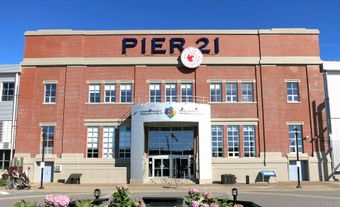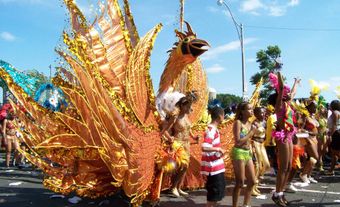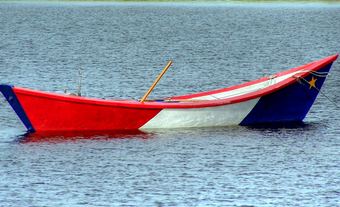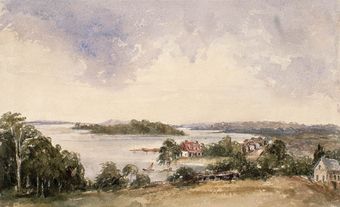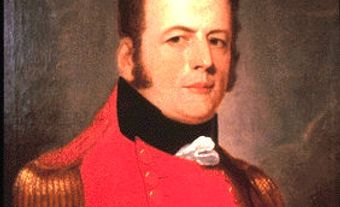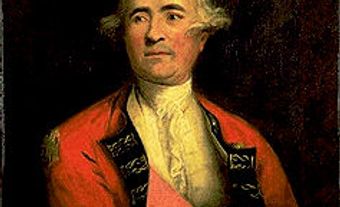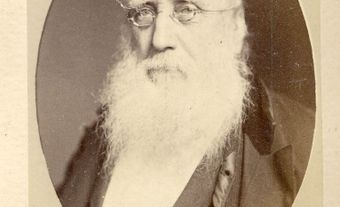Swiss immigration to the territory we now know as Canada began in the late 16th century. The 2016 census reported 155, 120 people of Swiss origin in Canada (25, 235 single responses and 129, 885 multiple responses).
Background
Switzerland is a small, landlocked country surrounded by France, Germany, Italy and Austria. The Swiss confederation was founded in 1291. It experienced a turbulent history until the mid-1800s. Three of the four official languages of Switzerland - French, German and Italian - are shared with its neighbour states. The fourth language, Rumantsch, is spoken primarily in isolated valleys of the Grison region.
Early Arrivals: Swiss Mercenaries in Canada
In 1604, a small unit of Swiss soldiers and officers in the service of the French Crown set up camp on the Island of Ste.- Croix, which became the birthplace of Acadia. A drawing published by French explorer Samuel de Champlain in 1613 shows a small settlement established by Pierre DuGua de Monts. It depicted a barracks for Swiss soldiers. The most prominent Swiss immigrant in 17th-century New France was Jacques Bizard (1642-92), a mercenary who, in 1672, arrived as aide-de-camp to Louis de Buade, Comte de Frontenac . In 1678, under the seigneurial system of New France, he was made seigneur of Île Bonaventure, which was later renamed Île Bizard.
From the 16th to the mid-19th century, the Swiss were sought after because of their military skills and discipline, honed during centuries of bloody struggle for independence. Swiss mercenary units were distinct from other armies. Commanded by members of Swiss patrician families, they formed their own regiments. Two Swiss regiments, de Meuron (named after Colonel Charles-Daniel de Meuron), and de Watteville (named after Louis de Watteville), were allied, but not integrated, with the British army in North America.
The de Watteville regiment played a prominent role in the War of 1812, capturing Fort Oswego from the Americans. The De Meuron regiment saw its first action near Fort Champlain, later in Plattsburg, NY. When it was disbanded in 1816, 353 officers and men stayed behind in Canada. The new settlers were directed to settlements at Perth and Drummondsville. Unused to the hardships of pioneer life, many de Meurons left for the US or returned to Europe.
Sir Frederick Haldimand is well known among Swiss soldiers who served in Canada. After service in Prussia and Holland, he transferred to the British army in 1756. He served in North America during the Seven Years’ War. After the Conquest of New France, he was twice military governor of Trois-Rivières. Haldimand, being of French-speaking origin, had great empathy with the preoccupation of French-speaking colonists not to be submerged under British dominance. As governor of Quebec, Haldimand concentrated on defending the province militarily and the status quo politically.

Another well known military figure is Sir George Prevost, born in New Jersey to a Swiss officer. In 1811 he assumed double duties as governor general of the Canadas and commander-in-chief of the British troops in North America. He was instrumental in persuading the British colonial office in London to recognize previous French institutions.
Early Swiss Settlers
Early Swiss settlers, merchants and pioneers include Pierre, François and Jacques Miville, who were granted lands in 1665 at Le Grand Anse, now La Pocatière, Quebec. This area is still popularly known as "Le canton des Suisses." Another settler, merchant Laurenz Ermatinger arrived in Montreal around 1761 and later became one of nine partners in the new North West Company. Charles Oakes Ermatinger, a son of Laurenz, contributed decisively to extending the fur trade around Sault Ste Marie, Ontario. Sebastian Fryvogel (1791-1873) is a Swiss-born pioneer credited with helping to open up the Huron Tract, the vast lands east of Lake Huron. The founding of Zurich, Ontario, in 1856 is credited to Frederick Knell, who bought land southeast of Lake Huron and named it after the capital of his home canton.
The Selkirk Expedition to the Red River
Because of his positive experience with the de Meurons, Lord Selkirk sent an agent to Switzerland to recruit civilians to emigrate to the Red River Colony. After the War of 1812, a hundred men from the disbanded Swiss regiments were hired by Lord Selkirk to accompany him there. After occupying Fort William, a small detachment of 30 soldiers and 2 officers continued west and entered Fort Douglas by the Red River, re-establishing order. Some of these soldiers stayed on as settlers. Today the Avenue des Meurons in Winnipeg, Manitoba and the Point de Meuron nearby are reminders of the Swiss regiment's settlers.
In 1821, after a journey of unremitting hardship, 180 new settlers arrived in November, only to find that no cabins had been built for them. Nor were there enough provisions. About half of the new arrivals had to set off for Pembina near the US border, where conditions where believed to be more favorable. Three years of flooding and plagues of locusts drove most inhabitants of the Red River Colony to greener pastures.

Peter Rindisbacher, who had at age 15 come with his family to Red River, made a number of watercolour sketches of the Swiss immigrants' journey. His depictions of Indigenous and trader life on the prairies are a valuable historical and artistic record of that period.
Other early Swiss settlers in the West include Captain Louis Agassiz, who found a position as head of police in the Hope district of the Fraser River. Christian Fahrni was first in establishing regular wagon service between Fort Garry andFort Edmonton (see also Upper Fort Garry; Lower Fort Garry.) Since 1935, Smithers, British Columbia, has had a flourishing Swiss community of more than a hundred, many engaged as geologists, mining engineers, teachers and surveyors.
Swiss mountain guides came to Canada at the turn of the 20th century in the service of the Canadian Pacific Railway, which intended to foster tourism for its newly built hotels in the Rocky Mountains. For 20 years Swiss guides assisted mountaineers from Canada, the US and Europe in numerous first ascents in the Rockies. Although the Second World War (WWII) brought the golden pioneer days of first ascents and tourism in the Rockies to an end, there are still many Swiss as mountain guides, ski instructors, photographers and filmmakers in Canmore, Banff and Jasper, Alberta, and Golden, BC.
Immigration After WWII
Swiss immigration diminished greatly after 1914 and did not resume until after 1945. A higher proportion of immigrants in the post-WWII years were professional and entrepreneurial individuals. Many moved to urban centres, where you could find Swiss clubs, associations and bulletins. A significant number of Swiss immigrants came to obtain foreign experience in their chosen field and then returned home.
From the 1930s onward, Swiss banks and insurance companies opened branches in Canada (eg, Swiss Bank Corp, Zurich Insurance). The multinational Swiss-based chemical giants Sandoz, Ciba-Geigy and Hoffman LaRoche (now merged as Novartis) opened factories and research labs in Montreal. Machine manufacturers Sulzer Brothers and Brown-Bovery (now ASEA) with head offices in Baden, and Oerlikon Zurich enterprises opened factories in Canada, as did the largest nationwide building product company, St Laurent Cement, in Quebec. The contribution made by these corporate giants to Canada's economy numbers in the billions.
Prominent Figures
Swiss scientists and academics in Canada have worked in many disciplines. Swiss physicists were attracted to the research facilities in particle physics at the TRIUMF Centre in Vancouver. John Turque, a notable Swiss engineer who arrived 1937 in Montreal, founded the CNC group, the general contractor for the international airport at Mirabel. In the field of medical science, Dr. Erwin Diener was instrumental in 1973 in establishing the first university department of immunology in Canada at the University of Alberta.
Swiss writers, artists and musicians have historically been most active in Quebec, which has long attracted Swiss immigrants. Napoléon Aubin (1812-90) was a prolific writer, journalist and publisher who in 1845 became editor of Le Canadien. André Borel, another Swiss writer in Montreal, published Croquis du Far-West and Le Robinson de la Red Deer. P.-E. Briquet wrote Croquis Canadien for the Journal de Genève. Auguste Viatte's Histoire Litteraire de l'Amerique Francophone (1954) became a classic. Laure Rièse received the French Legion of Honor for her work in promoting the French language, and for her authorship.
Apart from Peter Rindisbacher and André Charles Biéler, there have been other Swiss painters, especially in the Toronto area. The main activity of Swiss immigrants in the visual arts in Canada has been in photography (Robert Frank), and more prominently in graphic art and design, where Swiss designers in the 1970s introduced the first undergraduate and graduate programs in visual communication design in Canada at the University of Alberta.
Swiss conductor Charles Dutoit was the Montreal Symphony Orchestra’s artistic director from 1977 to 2002. Other Swiss musicians who have played leading roles in Canadian music include Mario Duschenes, flutist and composer, and Pierre Souvairan, pianist and composer. Regula Burckhardt-Qureshi, a gifted musician herself, has made unique contributions to ethnomusicology.

 Share on Facebook
Share on Facebook Share on X
Share on X Share by Email
Share by Email Share on Google Classroom
Share on Google Classroom
